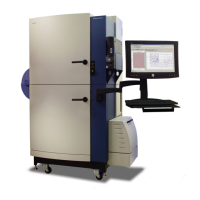FLIPR
®
Tetra High Throughput Cellular Screening System User Guide
0112-0109 H 169
Optimizing Pin Tool Delivery
To ensure proper transfer of compound using a pin tool to your target
plate, we recommend you evaluate the following factors during assay
development. Controlling and standardizing these factors for a given
application will help you deliver reproducible volumes.
• Pin diameter
• Surface tension of the liquid being transferred
• Surface tension of the pin
• Speed of removal from source liquid
• Speed of pin striking recipient plate
• Depth to which the pin is submerged in the source plate
• Depth to which the pin is submerged in the target plate
• Volume of slot in pin
• Surface tensions of plate and dwell time
For more information regarding optimization of pin tools, please refer to
http://www.vp-scientific.com/molecular_devices.htm or contact:
V&P SCIENTIFIC, INC.
9823 Pacific Heights Boulevard, Suite T
San Diego, CA 92121
Toll Free: +1-800.455.0644
Phone: +1-858.455.0643
Fax: +1-858.455.0703
Email: sales@vp-scientific.com
Optimizing Cell Delivery
During suspension assays, cells are pumped from the external Cell
Flask to the Cell Reservoir and pipetted to the read plate. There are
several user adjustable settings for suspension cell optimization. These
parameters need to be optimized for each cell line as each cell line is
different. The settings include:
• Stir speed in the Cell Flask
• Fill pump speed
• Drain pump speed
• FLIPR
®
Tetra System aspirating/dispensing parameters
Start the Assay Run
To start the assay:
1. Check the Experiment window to verify that the experiment
synopsis is accurate and that the appropriate *.fmp file is being
used.
2. Verify the plates and tips are loaded in the instrument.

